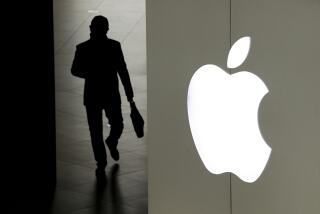Samsung copied iPhone, lawyer for Apple says in patent trial
SAN JOSE — After Apple co-founder Steve Jobs introduced the iPhone in January 2007, Samsung had two choices: It could beat Apple fairly in the marketplace, or it could make a copycat smartphone.
Samsung chose the second path, lawyer Harold J. McElhinny said during Apple Inc.’s opening statement in federal court Tuesday. He said Samsung Electronics Co. — whose smartphone devices looked bulky and plasticky before the launch of the iPhone — did what was “easier” and was soon developing a near-identical smartphone under the Samsung name.
“The iPhone, like all of Apple’s products ... is about creating a unique and special user experience. An experience that is so seamless and intuitive that it just feels right. It doesn’t come easy,” McElhinny said, adding that the launch of the iPhone was a big risk for the Cupertino, Calif., company. “Apple’s competitors immediately recognized the impact of this new device. These competitors included, as I mentioned, Samsung Electronics.”
As he addressed the nine-member jury (one juror was excused Tuesday morning), McElhinny compared images of Samsung’s old smartphones with its newer 2010 and 2011 versions and alleged that several aspects of the iPhone’s design — including its rectangular shape, rounded corners, large black screen and colorful icons — had been ripped off by Samsung.
McElhinny, of the firm Morrison & Foerster, said Samsung “failed to take reasonable steps” to prevent infringement of Apple’s products. “People should not use what you invented without permission,” he said.
Apple is seeking more than $2.5 billion in damages in the patent infringement case.
Samsung lawyer Charles K. Verhoeven began his opening statement by asking jurors to keep an open mind and telling them, “There’s more to the story than what you’ve just heard.”
“Samsung’s not some copyist, some Johnny-come-lately that’s doing knockoffs,” he said.
Verhoeven repeatedly insisted that an average person could tell the difference between Samsung’s mobile devices and Apple’s, and said Apple “had no right to claim a monopoly” on a rectangle with a large screen.
He told the jury that Samsung, just like other technology companies, was inspired by Apple’s iPhone but that didn’t constitute infringement.
“It’s called competition,” he said. “There’s nothing wrong with being inspired by someone else’s design.”
Verhoeven, of the firm Quinn Emanuel Urquhart & Sullivan, said Samsung’s recent mobile devices simply showed a natural evolution in smartphone technology. He said the South Korean company’s smartphones were fundamentally different from the iPhone, noting that, among other differing features, many Samsung smartphones have four buttons on the bottom of the device (compared with the iPhone’s single button).
Verhoeven said even Apple’s designers had admitted that they had no proof that customers had ever been confused between the two companies’ products. In fact, he said, other tech companies were already working on devices that looked like the iPhone and iPad before those products were even introduced.
The trial, which began with jury selection Monday, is expected to last about four weeks. U.S. District Judge Lucy H. Koh is presiding over the closely watched case, which technology and legal analysts have called the patent trial of the decade.
The outcome of the trial will have huge ramifications for the technology industry, said Christopher V. Carani, a design patent expert at intellectual property law firm McAndrews, Held & Malloy.
“If Apple wins, the consuming public can expect tech companies to peddle new distinctive designs. Companies will steer away from Apple’s designs,” he said. “If Samsung prevails, I think we’ll expect to see the market even further coalesce around this minimalist design.”
More to Read
Inside the business of entertainment
The Wide Shot brings you news, analysis and insights on everything from streaming wars to production — and what it all means for the future.
You may occasionally receive promotional content from the Los Angeles Times.









